Last Friday (March 10, 2023), the US Bureau of Labor Statistics (BLS) released their latest labour market data – Employment Situation Summary – February 2023 – which revealed a slight dip in the number of net payroll jobs created and a slight increase in the unemployment rate. It is too early to say whether this marks a turning point in the US labour market after several months of interest rate increases. We will know more about that next month. January’s result was very strong, so a slight dip on that is no cause for concern. Most of the aggregates are steady and in terms of the pre-pandemic period, February’s net employment change was still relatively strong.
Real wages continued to decline in the face of a decelerating inflation rate. Overall, the US labour market is steady and doesn’t appear to be contracting fast in the face of the Federal Reserve interest rate hikes.
Overview for February 2023 (seasonally adjusted):
- Payroll employment increased by 311,000 – down from the boom in January.
- Total labour force survey employment rose by 177 thousand net (0.11 per cent).
- The labour force rose by 419 thousand net (0.25 per cent).
- The participation rate rose by 0.1 point to 62.5 per cent.
- Total measured unemployment rose by 242 thousand to 5,936 thousand.
- The official unemployment rate rose by 0.2 points to 3.6 per cent.
- The broad labour underutilisation measure (U6) rose by 0.2 points to 6.8 per cent.
- The employment-population ratio was steady on 60.2 per cent (still well below the May 2020 peak of 61.2).
For those who are confused about the difference between the payroll (establishment) data and the household survey data you should read this blog post – US labour market is in a deplorable state – where I explain the differences in detail.
Some months the difference is small, while other months, the difference is larger.
Payroll employment trends
The BLS noted that:
Total nonfarm payroll employment increased by 311,000 in February, compared with the average monthly gain of 343,000 over the prior 6 months …
Leisure and hospitality added 105,000 jobs in February, similar to the average monthly gain of 91,000 over the prior 6 months … Employment
in leisure and hospitality is below its pre-pandemic February 2020 level by 410,000, or 2.4 percent.Employment in retail trade rose by 50,000 in February … is little changed on net over the year.
Government employment increased by 46,000 in February, about the same as the average monthly gain of 44,000 over the prior 6 months … Overall, employment in government is below its pre-pandemic February 2020 level by 376,000, or 1.6 percent.
Employment in professional and business services continued to trend up in February (+45,000) … had increased by an average of 35,000 per month
over the prior 6 months.Health care added 44,000 jobs in February, compared with the average monthly increase of 54,000 over the prior 6 months …
Construction employment grew by 24,000 in February, in line with the average monthly growth of 20,000 over the prior 6 months.
Employment in social assistance rose by 19,000 in February, similar to the average monthly gain of 22,000 over the prior 6 months.
In February, the information industry lost 25,000 jobs … has decreased by 54,000 since November 2022.
Transportation and warehousing lost 22,000 jobs in February … is down by 42,000 since October 2022.
Employment showed little change over the month in other major industries …
The first graph shows the monthly change in payroll employment (in thousands, expressed as a 3-month moving average to take out the monthly noise). The red lines are the annual averages. Observations between January 2020 and January 2020 were excluded as outliers.
The labour market boomed in January and there is no sign of collapse or a significant slowdown.
Some sectors, however, have still not regained the employment they lost in 2020-21.
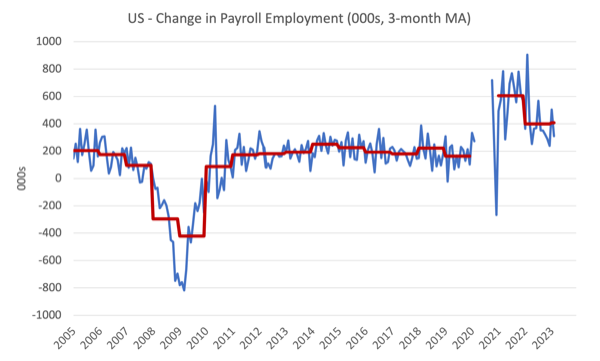
The next graph shows the same data in a different way – in this case the graph shows the average net monthly change in payroll employment (actual) for the calendar years from 2005 to 2023.
The red marker on the column is the current month’s result.
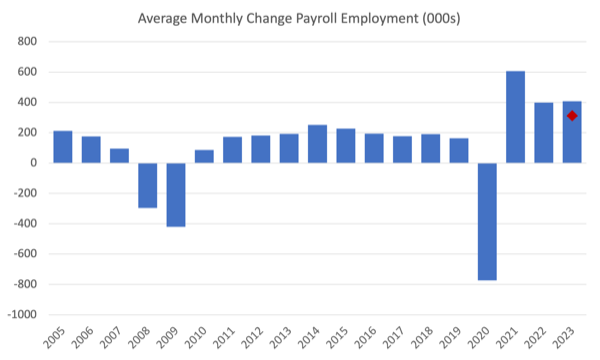
Average monthly change – 2019-2023 (000s)
| Year | Average Monthly Employment Change (000s) |
| 2019 | 163 |
| 2020 | -774 |
| 2021 | 606 |
| 2022 | 399 |
| 2023 (so far) | 408 |
Labour Force Survey data – employment rises and more working age people in jobs
The seasonally-adjusted data for January 2022 reveals:
1. Total labour force survey employment rose by 177 thousand net (0.11 per cent) – considerably slower growth than January.
2. The labour force rose by 419 thousand net (0.25 per cent) – also slower.
3.The participation rate rose by 0.1 point to 62.5 per cent.
4. As a result (in accounting terms), total measured unemployment rose by 242 thousand to 5,936 thousand and the official unemployment rate rose by 0.2 points to 3.6 per cent.
It is hard to make an assessment of the strength of the labour market. Last month’s data was exceptionally strong and may have elicited a rise in the participation rate as employment fell back to more ‘normal’ shifts, albeit on the slower side of that mark.
The following graph shows the monthly employment growth since January 2008 and excludes the extreme observations (outliers) between May 2020 and January 2020, which distort the current period relative to the pre-pandemic period.
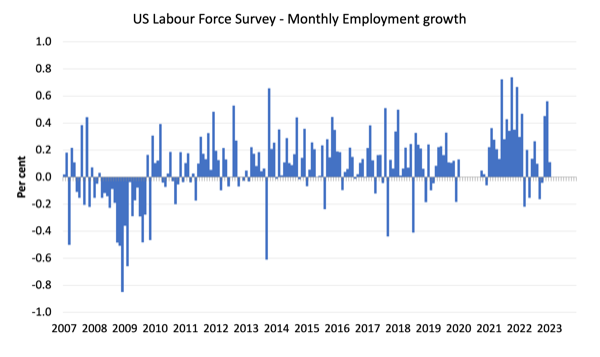
The Employment-Population ratio is a good measure of the strength of the labour market because the movements are relatively unambiguous because the denominator population is not particularly sensitive to the cycle (unlike the labour force).
The following graph shows the US Employment-Population from January 1950 to February 2023.
In February 2023, the ratio was unchanged on 60.2 per cent.
The peak level in May 2020 before the pandemic was 61.1 per cent.
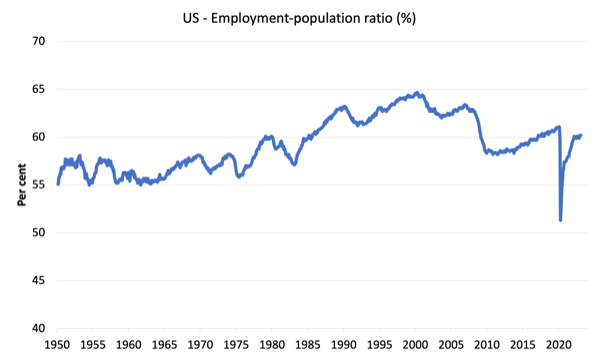
Unemployment and underutilisation trends
The BLS note that:
Both the unemployment rate, at 3.6 percent, and the number of unemployed persons, at 5.9 million, edged up in February. These measures have shown little net movement since early
2022. …The number of persons jobless less than 5 weeks increased by 343,000 to 2.3 million in February, offsetting a decrease in the prior month. The number of long-term unemployed (those jobless for 27 weeks or more), at 1.1 million, changed little in February and accounted for 17.6 percent of the total unemployed …
The number of persons employed part time for economic reasons, at 4.1 million, was essentially unchanged in February …
The number of persons not in the labor force who currently want a job was little changed at 5.1 million in February.
So a fairly static picture.
Unemployment rose in February because employment growth was weaker than the growth in the labour force (given the slight participation rate increase).
The first graph shows the official unemployment rate since January 1994.
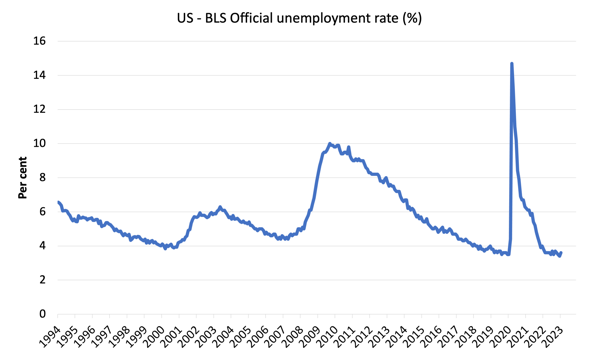
The official unemployment rate is a narrow measure of labour wastage, which means that a strict comparison with the 1960s, for example, in terms of how tight the labour market, has to take into account broader measures of labour underutilisation.
The next graph shows the BLS measure U6, which is defined as:
Total unemployed, plus all marginally attached workers plus total employed part time for economic reasons, as a percent of all civilian labor force plus all marginally attached workers.
It is thus the broadest quantitative measure of labour underutilisation that the BLS publish.
Pre-COVID, U6 was at 6.8 per cent (January 2019).
In February 2023 the U6 measure was 6.8 per cent, up by 0.2 points as a result of the unemployment rising with other determining factors largely unchanged. It has risen 0.3 points since December 2022.
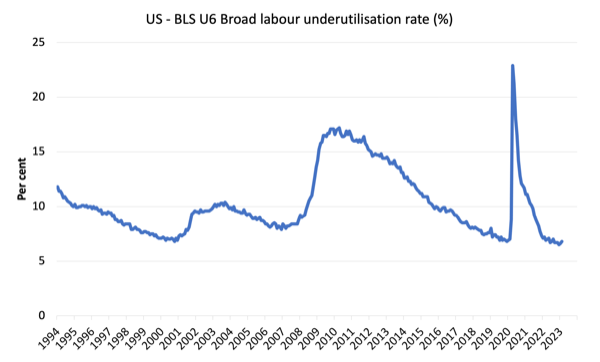
What about wages growth in the US?
The BLS reported that:
In February, average hourly earnings for all employees on private nonfarm payrolls rose by 8 cents, or 0.2 percent, to $33.09. Over the past 12 months, average hourly earnings have increased by 4.6 percent. In February, average hourly earnings of private-sector production and nonsupervisory employees rose by 13 cents, or 0.5 percent, to $28.42.
These are modest increases relative to the current inflation rate.
However, the latest – BLS Real Earnings Summary (published February 14, 2023) – tells us that:
Real average hourly earnings for all employees decreased 0.2 percent from December to January … This result stems from an increase of 0.3 percent in average hourly earnings combined with an increase of 0.5 percent in the Consumer Price Index for All Urban Consumers (CPI-U) …
Real average hourly earnings decreased 1.8 percent, seasonally adjusted, from January 2022 to January 2023. The change in real average hourly earnings combined with an increase of 0.3 percent in the average workweek resulted in a 1.5-percent decrease in real average weekly earnings over this period.
Overall, while the inflationary pressures are moderating, nominal wages growth is still lagging and the result is that real wages continue to fall.
The following table shows the movements in nominal Average Hourly Earnings (AHE) by sector and the inflation-adjusted AHE by sector for February 2023 (note we are adjusting using the January CPI – the latest available).
There is considerable disparity across the sectors, with most now seeing improving real wage outcomes (bar Transportation and Warehousing).
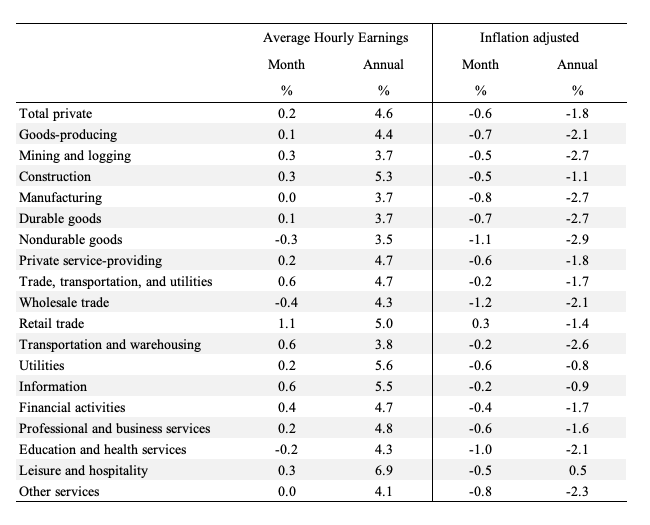
The following graph shows annual growth in real average hourly earnings from 2008 to February 2023.
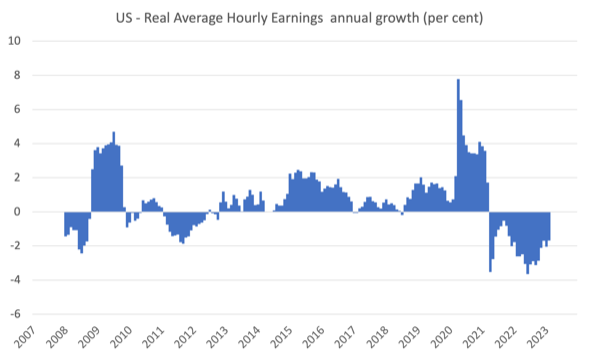
The other indicator that tells us whether the labour market is turning in favour of workers is the quit rate.
The most recent BLS data – Job Openings and Labor Turnover Summary (released March 8, 2023) – shows that:
The number of job openings decreased to 10.8 million on the last business day of January … Over the month, the number of hires and total separations
changed little at 6.4 million and 5.9 million, respectively. Within separations, quits (3.9 million) decreased, while layoffs and discharges (1.7 million) increased …In January, the number of quits decreased to 3.9 million (-207,000), and the rate was little changed at 2.5 percent.
If the US labour market was in retreat, then the quit rate would be falling. So in January there was just a hint that workers are reducing their quit behaviour – although the shifts are very small.
Conclusion
In February 2023, the latest US labour market data showed that January’s strong employment growth was probably an outlier and growth slowed.
But in terms of the pre-pandemic period, February’s net employment change was still relatively strong.
Unemployment increased because coupled with the slower employment growth, the labour force expanded faster on the back of a slight increase in the participation rate.
Real wages continued to decline in the face of a decelerating inflation rate.
Overall, the US labour market is steady and doesn’t appear to be contracting fast in the face of the Federal Reserve interest rate hikes.
That is enough for today!
(c) Copyright 2023 William Mitchell. All Rights Reserved.

